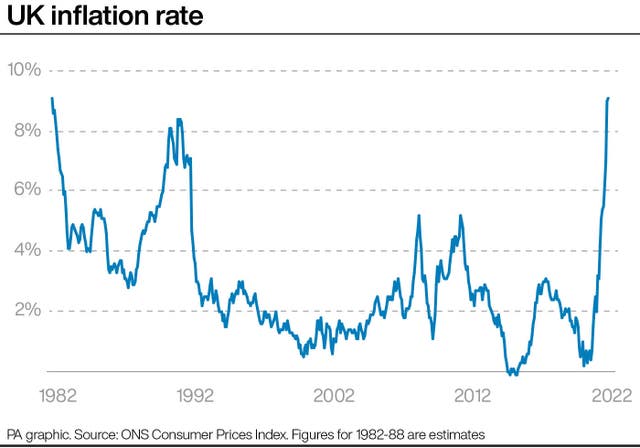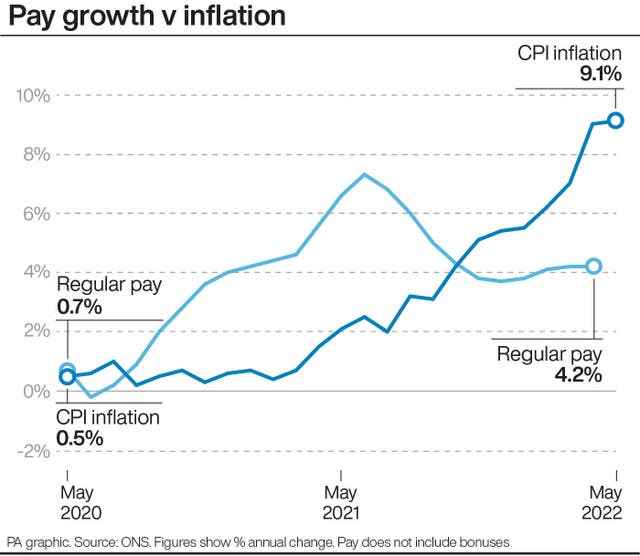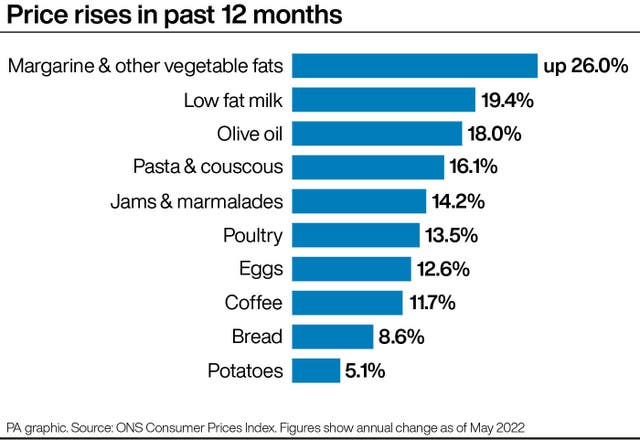The rate of inflation rose again in May, remaining at 40-year highs and deepening the squeeze felt by households across the UK, the Office for National Statistics (ONS) has said.
The rate of consumer prices index (CPI) inflation rose from 9% in April to 9.1% in May, the statisticians said.
The increase matches what analysts had expected and pushes the measure to its highest since early 1982, according to ONS estimates.
“Though still at historically high levels, the annual inflation rate was little changed in May,” said ONS chief economist Grant Fitzner.

“Continued steep food price rises and record high petrol prices were offset by clothing costs rising by less than this time last year, and a drop in often fluctuating computer games prices.
“The price of goods leaving factories rose at their fastest rate in 45 years, driven by widespread food price rises, while the cost of raw materials leapt at their fastest rate on record.”
The change was in large part driven by the increase in food prices, which added more than 0.2 percentage points to the inflation number, the ONS said.
Grant Fitzner also said: (3/3)
— Office for National Statistics (ONS) (@ONS) June 22, 2022
Clothing and footwear prices helped keep a lid on inflation, while recreation and culture prices also pulled it downwards.
The news will add to the difficulties faced by many people across the UK. Energy bills rose by 54% for the average household at the beginning of April and will remain at this level until October.
But forecasts released this week predict that the Government cap on energy bills could rise again from an already record high £1,971 to £2,980 in the autumn.
The Bank of England has predicted that inflation will spike at more than 11% in October after the price cap is changed again.
Shadow chancellor Rachel Reeves said: “Today’s rising inflation is another milestone for people watching wages, growth and living standards continue to plummet.
“Though rapid inflation is pushing family finances to the brink, the low wage spiral faced by many in Britain isn’t new.
“Over the last decade, Tory mismanagement of our economy has meant living standards and real wages have failed to grow.”

Chancellor Rishi Sunak said: “I know that people are worried about the rising cost of living, which is why we have taken targeted action to help families, getting £1,200 to the eight million most vulnerable households.
“We are using all the tools at our disposal to bring inflation down and combat rising prices – we can build a stronger economy through independent monetary policy, responsible fiscal policy which doesn’t add to inflationary pressures, and by boosting our long-term productivity and growth.”
The price of energy is not just feeding through to household energy bills.
Gas, oil and other fossil fuels are needed to make and transport many of the goods that households buy every month.
When the price of the fuel goes up, so does the price of the end product.
Energy prices have spiked over the last year. To begin with they started rising as the global economy started to reopen and demand for energy rose after the pandemic.
The Consumer Prices Index including owner occupiers’ housing costs grew 7.9% in the year to May 2022, up from 7.8% in the year to April https://t.co/xSN9anxUkm
— Office for National Statistics (ONS) (@ONS) June 22, 2022
The prices later worsened, especially in Europe, when Russia launched a full-scale invasion of Ukraine in February.
Russia is one of the world’s largest energy producers.
A breakdown from the ONS shows that the biggest increases in the 12 months to May were for fossil fuel products, including diesel, electricity, petrol and natural gas. These were, however, little changed from April.
Some of the biggest changes from April were food items. Ukraine is one of the biggest grain producers in the world and experts worried about what the war could do to global prices and availability.

The price of flour and other cereals in the UK had been decreasing before the war started, but has been ticking up since.
Between February and April price rises increased from 2.3% to 9.3%. But in May prices leaped and are now 16.3% higher than a year ago.
Price rises of olive oil also accelerated from 9.5% in April to 18% in May, the ONS said.
The statisticians said that the consumer prices index including owner occupiers’ housing costs (CPIH) rose by 7.9% in May from 7.8% in April.
The retail prices index, which is used to calculate train fares, rose from 11.1% in April to 11.7% in May.




Why are you making commenting on The National only available to subscribers?
We know there are thousands of National readers who want to debate, argue and go back and forth in the comments section of our stories. We’ve got the most informed readers in Scotland, asking each other the big questions about the future of our country.
Unfortunately, though, these important debates are being spoiled by a vocal minority of trolls who aren’t really interested in the issues, try to derail the conversations, register under fake names, and post vile abuse.
So that’s why we’ve decided to make the ability to comment only available to our paying subscribers. That way, all the trolls who post abuse on our website will have to pay if they want to join the debate – and risk a permanent ban from the account that they subscribe with.
The conversation will go back to what it should be about – people who care passionately about the issues, but disagree constructively on what we should do about them. Let’s get that debate started!
Callum Baird, Editor of The National
Comments: Our rules
We want our comments to be a lively and valuable part of our community - a place where readers can debate and engage with the most important local issues. The ability to comment on our stories is a privilege, not a right, however, and that privilege may be withdrawn if it is abused or misused.
Please report any comments that break our rules.
Read the rules hereLast Updated:
Report this comment Cancel